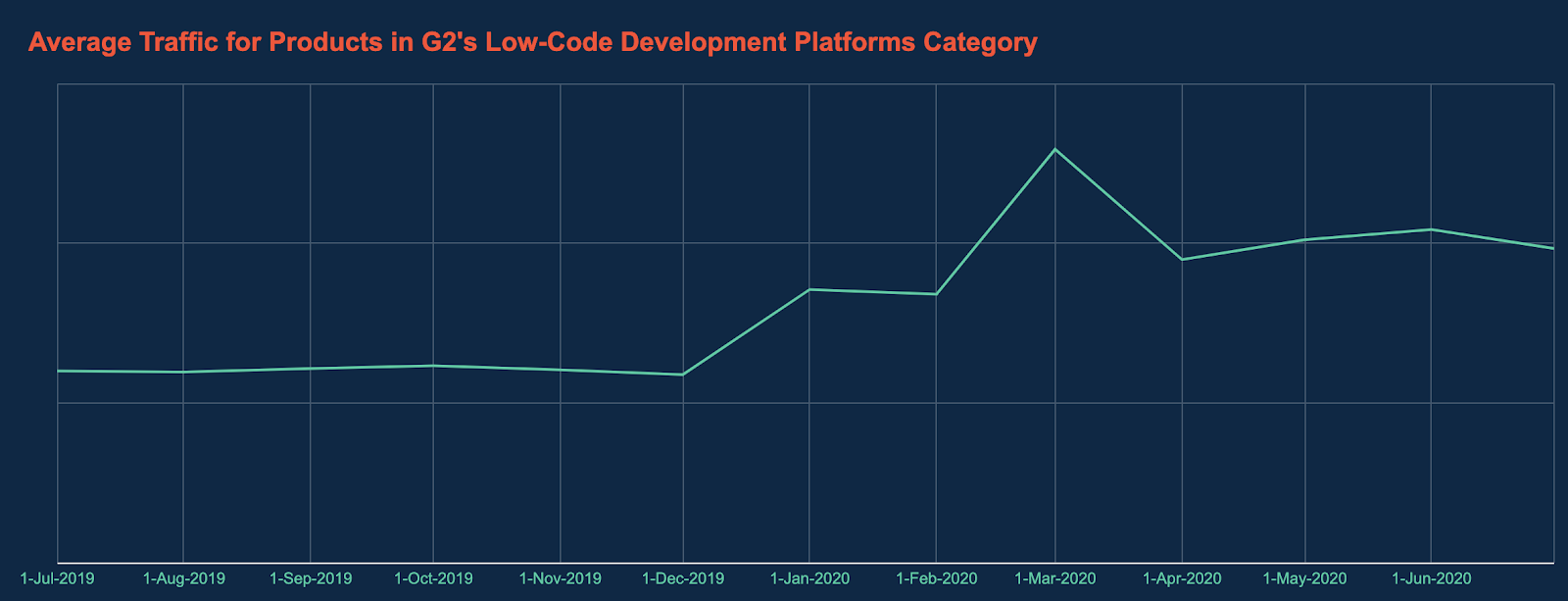At the end of 2019, G2 released its 2020 digital trends series highlighting anticipated software trends for the year to come. As part of that series, we took a shot at predicting software development trends. Notably, we predicted that rapid application development (RAD) would find its footing in the market after years of floating in a void between developers and non-developers.
Of course, nobody could have predicted the global pandemic we now find ourselves navigating. Those companies and employees who have the privilege of shifting to remote work have faced changes to their day to day, and software solutions have become key for businesses to adapt. In short, digital transformation is truly and fully here, and the circumstances that lead to its arrival couldn’t have been worse.
Businesses don’t necessarily need to employ a battalion of software developers to achieve and maintain digital transformation. RAD solutions offer companies a cost- and resource-effective way to build the tools and products they need by equipping existing team members with the right software. Non-developers can build business applications with no-code development platforms, while workplace innovation platforms grant development teams streamlined full-stack editing capabilities to improve company workflows.
| Read more: Build Custom Solutions with RAD Software to Solve Remote Work Issues → |
Given its flexibility, it makes sense that RAD software suits both non-coders and coders—but where does that leave low-code development platforms, which continue to see widespread adoption?
According to G2 data, low-code development platforms were one of our top 10 categories by review traffic for 5 straight weeks starting March 30th, 2020 and ending May 1st, 2020. Clearly low-code development solutions became a go-to as businesses adapted to remote work, but who are these platforms even for? Is the demographic of professionals who “took a Java class one time” really that big?
Cracking low-code
The very idea of low-code development raises a handful of questions. What does a low-code development platform achieve that a no-code platform doesn’t? Is “low-code” intended for developers, non-developers, or...sorta-developers? And what does a low-code future look like?
No-code versus low-code
To put low-code development platforms into context, it helps to understand its no-code counterparts.
No-code development platforms, drag-and-drop app builders, and “what you see is what you get” or WYSIWYG editors put digital transformation in the hands of non-developers by automating internal workflows and building customer-facing applications and websites without having to code. This allows users of all skill levels to stay competitive and keep pace with an increasingly software-dominated business world.
It’s easy to understand where no-code solutions fit within the market space, but where and why does low-code come in? Low-code marries streamlined RAD workflows with the customization and flexibility enabled by full-stack development. The issue lies in ensuring that developers can trust these tools to handle mission-critical tasks and that non-developers don’t overlook low-code for seeming too development centric.
Low-code platforms’ identity crisis
Low-code platforms find themselves seated in a relatively grey market space between two different kinds of users. In concept, the software is either intended as a way to make development more efficient for users with programming knowledge or to make programming less intimidating for users who want to build their own solutions.
On the dev side, some low-code products tout themselves as full integrated development environments (IDE) with automated functionality for filling in common code syntax. However, most low-code products have more in common with their drag-and-drop, no-code counterparts, distinguishing themselves by emphasizing on custom programming for any usable element in the low-code workspace.
At G2, our definition of low-code development platforms aligns more with the latter. Identity crisis solved! Thanks for reading!
If only it were that simple.
The reality remains that while low-code development platforms are well-defined products, historically they have struggled to settle between developer and non-developer use cases. These dual purposes aren’t necessarily a negative thing, but a lack of clear focus can cause confusion for buyers. Non-developers can have a hard time finding the right digital transformation solution if its branding makes it appear dev-oriented, while developers might not trust solutions that appear too “casual”.
 Actual traffic numbers have been hidden to maintain confidentiality
Actual traffic numbers have been hidden to maintain confidentiality
No “I” in low-code
So why did a global pandemic suddenly spark such interest in these tools? The answer is that low-code products, when marketed effectively, make clear to buyers that they are not simply for use by one persona or the other—they’re collaborative. In a team setting, non-developers can design and create an application that suits their vision, with developers filling any gaps where custom coding is necessary. The result is a one-stop-shop solution that breaks down silos for smooth, efficient digital transformation. Prior to the pandemic, digital transformation was optional. Now it’s a fact of life, and businesses are adopting the software that will best help them adapt.
Looking forward
We should not expect the sudden surge of low-code platforms to fizzle out any time soon. While dire situational necessity appears to have cleared some confusion around their purpose, the benefits of incorporating these platforms are permanent. Companies using low-code development platforms ultimately foster more agile and collaborative work environments. These products will serve as an essential asset now and will continue to provide a competitive advantage in the future.
Want to learn more about Integrated Development Environments (IDE)? Explore Integrated Development Environments (IDE) products.

Adam Crivello
Adam is a research analyst focused on dev software. He started at G2 in July 2019 and leverages his background in comedy writing and coding to provide engaging, informative research content while building his software expertise. In his free time he enjoys cooking, playing video games, writing and performing comedy, and avoiding sports talk.
